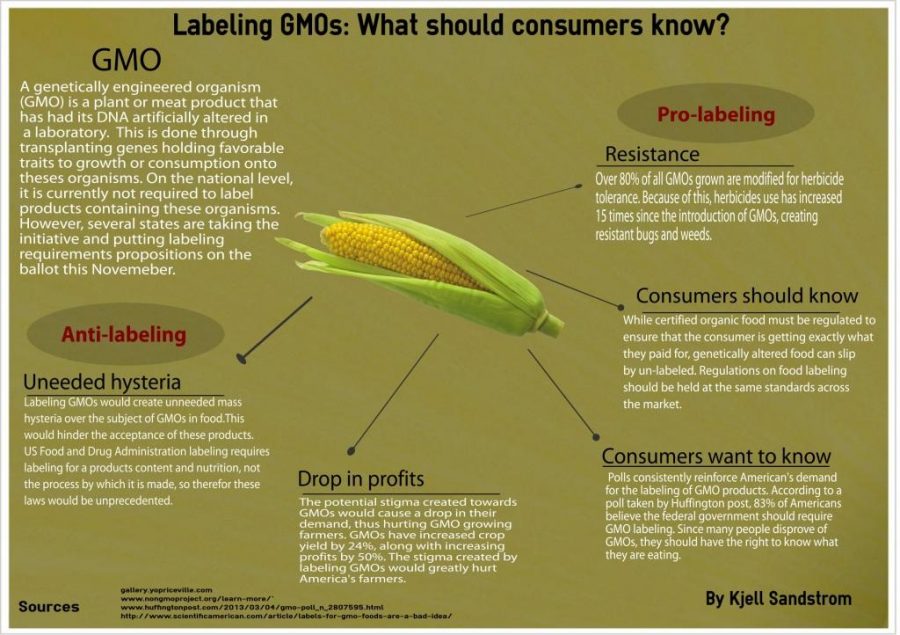Time to indicate GMO health risks on food labels
Genetically modified organisms, commonly known as GMOs, are organisms that have been genetically enhanced or modified by scientists for various purposes. They are commonly found in the foods consumers eat every day. Scientists engineer these organisms by using DNA from viruses, bacteria or other plants and animals to create something new. Consumers are unaware of GMO presence in their food due to the lack of labeling on packages.
Genetic crosses and combinations like these cannot occur naturally or from common crossbreeding. Studies have shown that because of GMO’s unnatural and inorganic qualities, they present potential health risks. GMOs need to be labeled in order to inform the public of the health risks GMOs possess and allow consumers to choose whether or not to allow them in their bodies.
GMOs are surprisingly common in everyday foods. It has been estimated that currently 75 percent of processed foods contain genetically modified or engineered ingredients. Processed foods are not the only common GMOs found today. More than 85 percent of corn grown in the U.S. is genetically engineered, while 91 percent of soybeans and 88 percent of cotton are also genetically engineered. In some cases, genetically modified food contains pesticides right inside the organism such as Bt-Corn.
Though not genetically engineered themselves, most livestock Americans consume have been raised off of animal feed containing GMOs. Genetically modified animals have not yet been introduced to market, but a genetically engineered salmon is pending FDA approval. The rise of products containing genetically modified ingredients found on supermarket shelves and their increasing use in crops are another reason why labeling of GMOs should be done.
Studies done by the same corporations that created GMOs claim that the use and consumptions of these organisms is safe, however, the American Academy of Environmental Medicine (AAEM) reports otherwise. Several animal studies done by the AAEM indicate that consumption of GM food lead to serious health risks. In some cases, immune problems, infertility, accelerated aging, faulty insulin regulation, and changes in major organs and the gastrointestinal system were reported. Before the FDA allowed GMOs to be produced and sold without labeling, FDA scientists warned that GM foods could create unpredictable and hard to detect side effects such as allergies, nutritional problems and new diseases. Since then, reports of death and infertility in animals after consuming GM foods such as soy have been reported. If GMOs present threats as real as the ones reported, labeling of GMOs should be done right away.
Most developed countries already consider GMOs as potential health risks. In over 60 countries around the world, including Japan, Australia and all of the countries in the European Union have already banned GMOs or have significant restrictions on them. This alone should spark the United States to label and or outright ban the use of GMOs in crops and foods.
Although the health risks GMOs possess are serious and further testing is needed to ensure consumption safety, GMO crops yield much larger quantities of produce than organic crops. These crops can be disease resistant leading to an increase in food supply and with added nutrients, can help underfed nations.
GMOs are increasingly common and present potential health risks as reported by the AAEM and FDA, and many developed countries have already taken the step toward banning and labeling of these organisms. However, labeling of GMOs in the U.S. has not yet been done. To ensure the safety and health of consumers, understanding the risks GMOs possess and the labeling of GMOs needs to be done.








Mackenzie Bottolfson • Dec 15, 2014 at 4:23 pm
I really like how you presented your opinion; it was simple and to the point. Your nutgraph was a very nice summary of what GMO’s are and the problem at hand. The facts and statistics were strong, but I felt that the article was a bit repetitive.